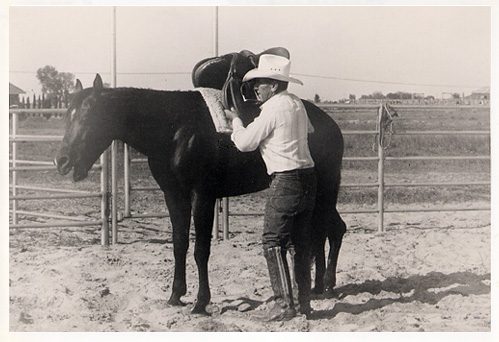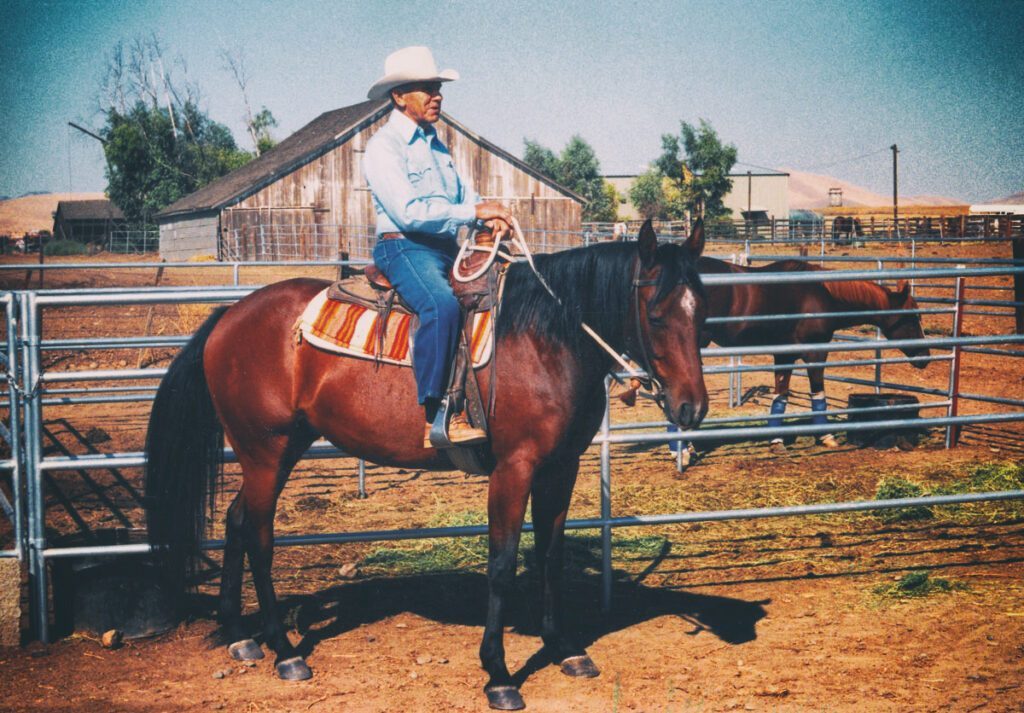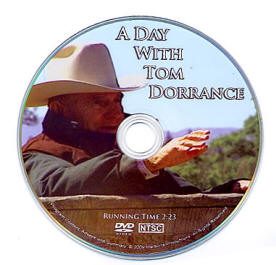This two-and-a-half hour DVD presents Tom Dorrance in his late days. He was interviewed and presented several horses and horse problems in order to understand his philosophy and more practical techniques. It can be interesting to watch him giving advises, yet the rider does not always understand very well the instructions and we end up sometimes with someone trying to get Tom Dorrance’s idea without real success. An interesting complement to the book, but not necessary.
Table of Contents
“It is a matter of listening and understanding what the horse is trying to tell us.”
A Day With Tom Dorrance
A Day With Tom Dorrance is a DVD of almost unedited footage, two and a half hours spent with Tom Dorrance to discuss particular horse problems and see how he solves these issues. It is commonly accepted that Tom Dorrance was one of the greatest horsemen, and reading his book True Unity is definitely a jewel in the mass of business books published every year. Whereas, I was not convinced by the DVD. We can hear Tom Dorrance enunciate some of his principles as he is presented different horses having different horse problems. Seven horses are studied, from simple issues to more technical problems.
Basic riding exercise
The first horse is quite young, and Tom Dorrance is asked to give general tips on horseback riding. This case is the opportunity to talk about timing: turning on time. The exercise is to ride without touching the reins, after a few steps simply lift the rein when the foot leaves the ground. Release as soon as the foot goes down. Repeat on both sides.
“Let a horse satisfy its curiosity.”
A Day With Tom Dorrance
Later, send the horse on a trot, stop your hands in mid air _ that is take the slack out _ and wait until the horse stops. Keep the slack out and wait for a few steps back. This way of riding is used in order to build lightness, softness, and to prevent any rodeo behaviour.
Doesn’t like to be cinched
The second horse is just used to bite when cinched up, and Tom Dorrance explains how you should block your horse with your elbow or your hand right before he starts to turn his head around to bite or push. Make it clear that such behaviour is not acceptable.
Doesn’t load into the trailer
The third horse presents a common problem, that is to be scared to death to get into a trailer. Tom Dorrance uses the pressure and release principle to get the horse in the trailer. He actually uses food at the beginning and it is important to understand that food is used in order to get the horse relaxed. That is where the DVD could have been better: Explanations! Seeing this video, at first sight we could actually think that Tom Dorrance simply proposes to lure a horse with food. That is quite short.
If you listen carefully to the horseman, and that you keep his writing in mind, then you understand that in the case of this specific horse, food is used as a tool to get him relaxed and more comfortable. With another horse, we could have used petting and rubbing only. The idea is to give the horse peace in a situation where he is not used to feel good. Later, Tom Dorrance and another man lay a rope on the ground, a third man leads the horse over that rope back to the trailer.
The first two come from behind with the rope to put pressure on the horse’s hind end until he gets into the trailer. Then, it is time to teach the horse to get out of the trailer, backing up smoothly. Next, they repeat the loading in and out, but do not go away before loading him again, and again, and again. I was actually disappointed by the process used here as we may not have two people and a ball of hay every time we want to load a horse. For this matter, Buck Brannaman’s method to load a horse in a trailer is a lot more interesting and efficient on my mind.

Doesn’t like to give the feet
The fourth horse is anxious when the farrier comes. Tom Dorrance advises to pet the horse all over the body from head to toe to make him understand you will not hurt him. Then, grab the foot and play with it, pet and rub, release when the horse is relaxed.
“Present yourself in a way that is understandable to the horse.”
A Day With Tom Dorrance
Doesn’t stand still when tied
The fifth horse is reputed to bite the rope, kick the stall or trailer, etc. Tom Dorrance uses pebbles that he throws up above the level of the horse’s hip so he can see them falling down. That brings his attention to the pebbles instead of the trailer/stall where he is tied up as he will try to avoid them… That is a good illustration of how Tom Dorrance considers horses as individual minds, demanding reasoning and thinking to solve specific troubles.
Doesn’t stay calm when getting into a crowded arena
“If a young horse feels like it has to move, let it move but direct it.”
A Day With Tom Dorrance
The sixth horse is a barrel race horse that has not been correctly started and moves fast all the time, being anxious, and stressed. The horseman gives us the advice to turn the horse from a direction to the other, petting him during the changes until he gets more relaxed, and slows down. Then, we should repeat the process until the horse stays on a good smooth walk.
Later, we can move the horse in tight circles until he starts to slow down and stop. When we get on the horse, if he wants to start before we are on, we should raise our hand holding the rein at once. The idea is to raise the hand right before it happens, to think like the horse, and to feel his reaction in advance.

Doesn’t feel good with the bit
The seventh and last horse is busy with the bit, raising the head and clearly looking anxious. Lack of lightness prevents a horse to understand that you want to go to his legs when you make contact with his mouth. Pulling very lightly, and waiting for a step or two, will help to build lightness and softness.
Good Tom Dorrance, but nos as good as True Unity
As a conclusion, there are some interesting tips presented in this DVD but I think it can be watched only as an illustration of the book True Unity that contains all the knowledge distilled by Tom Dorrance.
